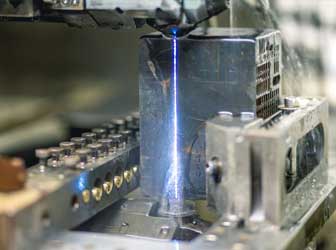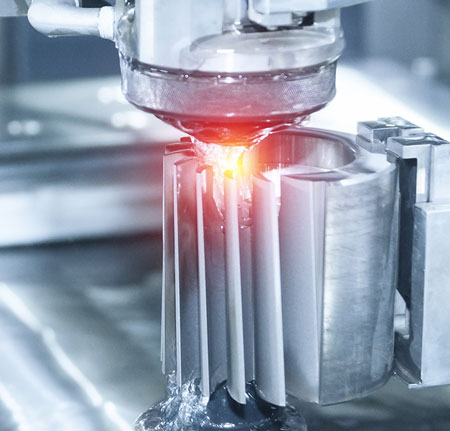
It is also known as electroerosion machining, wire cutting. A thin, continuously passing wire from EDM-TEC serves as the processing electrode.

The EDM-TEC EDM wire is wound on a spool and is guided from there via deflection rollers and the brake roller to the upper wire guide. Two opposite drive rollers pull the EDM-TEC wire with a defined wire tension in the range from 5 to 25 Newton and a speed of up to 25 m/min through the workpiece and the lower wire guide and then dispose of it. The wire guides above and below the workpiece guide and support the EDM-TEC wire and suppress vibrations. Furthermore, the wire guides are used to have a defined deflection point for taper cutting. The workpieces are cut in a liquid dielectric. This consists of deionized water. Some special machines also work with eroding oil. The dielectric disposes of the erosion waste from the cutting gap by means of permanent flushing and cools the EDM-TEC wire, which has to absorb a high current with a small cross-section.
The erosion process begins either at a starting point at the edge of the workpiece or in a starting hole. This is inserted into the workpiece beforehand by drilling or die-sinking EDM. The EDM-TEC EDM wire must be threaded through this.
Basically, the EDM-TEC eroding wire is positive and the workpiece has a negative polarity. As a result, the electromigration that is also relevant for ablation takes place away from the workpiece (metal ions are positively charged). The polarity can also be different or alternating in the recut sections. This depends on the technology of the respective machine manufacturer.
If the EDM-TEC EDM wire approaches the workpiece at a very small distance, an electric field forms at the point with the smallest distance, in which positively and negatively charged ions are strongly accelerated. These ions form an ionized channel between the workpiece and the electrode that conducts electricity. Now the ions in the final charge channel collide, resulting in a visible spark. At the same time, a gas bubble is formed from the evaporating dielectric and material (electrode and workpiece). In the gas bubble, the pressure rises steadily and plasma is formed. The bubble expands until it is spatially limited by the electrode and workpiece. Now the current is interrupted by initiating the pulse pause and the bubble implodes. The implosion causes molten material to be torn out of the workpiece and also from the electrode. If the pulse pause is initiated too late (pulse duration too long), an arc can occur which leads to a wire break.
The generator settings for the operator are stored in technologies by the manufacturer. They contain e. g. discharge duration, discharge pause, current strength as well as voltage (also open circuit voltage), capacitor capacity, operating voltage (servo voltage), maximum feed rate and the basic generator circuitry (mode or pulse mode).
The maximum generator power of wire EDM machines is usually indicated with their roughing power in square millimeters per minute (mm²/min). Meanwhile, there are machines working with up to 500 mm²/min. However, since such speeds destroy more than is economically viable, 150 mm²/min to 250 mm²/min is used for the main cut or roughing cut (cut through full material). The reference height of 60 mm applies.
Low generator settings are often trimmed to achieve higher accuracy and better surfaces. In order to achieve accuracy in the range of less than 2 µm, up to eight trimmings are made, depending on the manufacturer.
Further erosion methods are die-sinking EDM and drill erosion.
Brass is mostly used as wire material. Copper, tungsten and steel are also increasingly being used. To increase cutting performance and accuracy, EDM wires are coated and/or heat treated with zinc and other materials. The standard diameter is 0.25 mm in Europe and 0.2 mm in Asia. EDM-TEC EDM wires are available in the range from 0.02 mm to 0.33 mm due to their high tolerance (1 µm to 2 µm).